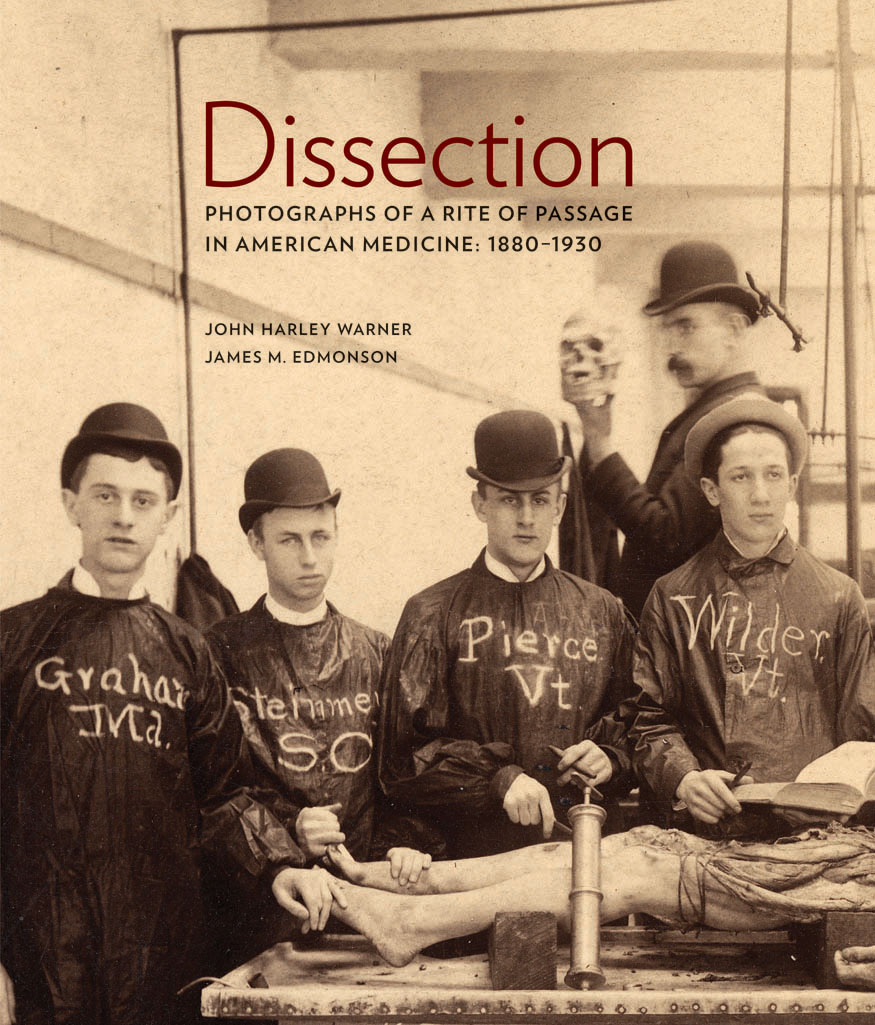

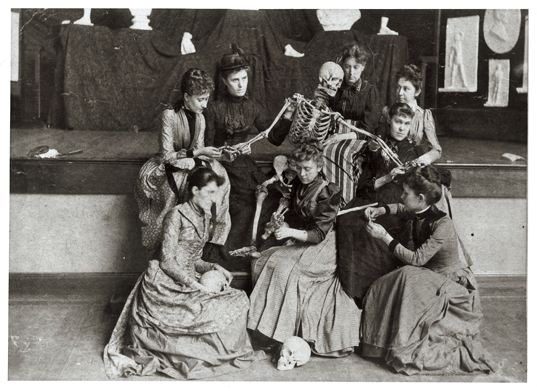
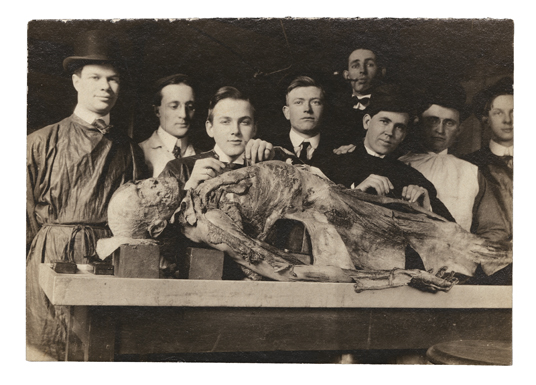
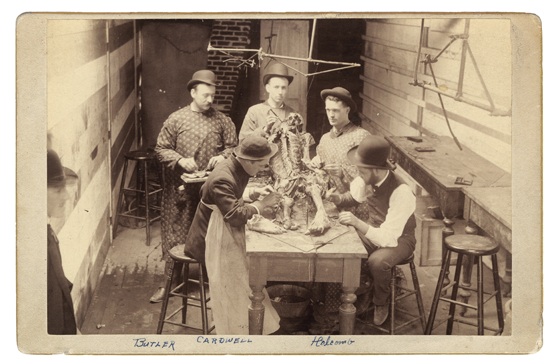
I just got my hands on the new Blast Books offering Dissection: Photographs of a Rite of Passage in American Medicine 1880–1930, by John Harley Warner and James M. Edmonson. You might be familiar with Blast Books from other wonderful publications such as the Mütter Museum calendars and books, and this book is just as memorable and essential as those previous releases. The book is large-scale, beautifully produced, and filled with fascinating and haunting photographs (such as those shown above; click on images see larger versions) so wonderfully reproduced that you feel you could walk right into them. The introductory essays by Warner and Edmonson do an admirable job of parsing this overlooked genre of photography and providing a sense of context for images so unusual and sensational to the modern eye.
I asked Laura Lindgren, co-publisher of Blast Books and the editor and designer of this tome, to give me some information about the book and send me a few of her favorite images (which I have featured above). Here's the press release she sent:
DISSECTION Photographs of a Rite of Passage in American Medicine 1880–1930The book has been (rightfully) been getting a lot of excellent press; see the New York Times review by clicking here and the Slate.com writeup by clicking here; You can also read Bioephemera's thoughtful response here. It is nice to see that audiences are responding so positively and with great interest to what, I was afraid, might be seen as rather off-putting images to the larger public.
by John Harley Warner and James M. Edmonson
Blast Books, 2009
Featuring 138 rare, historic photographs, Dissection is a “landmark book” (Ruth Richardson) that reveals a startling piece of American history, the rite of passage into the mysteries of medicine captured in photography.
From the advent of photography in the 19th century and into the 20th century, medical students, often in secrecy, took photographs of themselves with the cadavers that they dissected: their first patients. The photographs were made in a variety of forms, from proud class portraits to staged dark-humor scenes, from personal documentation to images reproduced on postcards sent in the mail. Poignant, strange, disturbing, and humorous, they are all compelling.
These photographs were made at a time when Victorian societal taboos against intimate knowledge of the human body were uneasily set aside for medical students in pursuit of knowledge that could be gained only in the dissecting room. Dissection, writes Mary Roach, “documents—in archival photographs and informed, approachable prose—a heretofore almost entirely unknown genre, the dissection photograph.”
“Without looking,” writes John Harley Warner, “we cannot see an uncomfortable past and begin to understand the legacies that American doctors and patients live with today.” That uncomfortable past saw the gradual passing of state laws, from 1831 to 1947, to govern the awkward business of cadaver supply—ever inadequate—bringing an end to reliance on professional “resurrectionists,” grave robbing, and dissection as an extended punishment for murder and as a consequence of poverty.
As James Edmonson notes, “Unsettling though these images may be, they are a thread connecting us to the shared experience among medical professionals over generations. . . . As medical schools explore alternatives to human dissection, this rite of passage may disappear.”
Together, the remarkable archival photographs and illuminating essays in Dissection present the astonishing social realities of the pursuit of medical knowledge in 19th- and early-20th-century America.
About the authors: John Harley Warner, PhD, is an historian who focuses chiefly on American medicine and science. In 1986 he joined the Yale faculty with a primary appointment in the School of Medicine, where he is now Avalon Chair of the Section of the History of Medicine. James M. Edmonson, PhD, is Chief Curator of the Dittrick Medical History Center and Museum of Case Western Reserve University in Cleveland.
About Blast Books: Celebrating our 20th anniversary in 2009, Blast publishes books on cultural and historical phenomenons, from Mütter Museum to Mental Hygiene. Visit www.blastbooks.com.
Praise for Dissection
“An extraordinary collection of photographs that makes even today’s flesh-and-blood anatomy laboratories look tame. . . . Forget the truckloads of grandiose prose that has been spun about the art and science of medicine over the centuries: one look at this picture [page 188] and you understand what it is all supposed to be about.”—Abigail Zuger, MD, The New York Times
“This is the most extraordinary book I have ever seen [and] the perfect coffee table book for all the households where I’d most like to be invited for coffee.”
—Mary Roach, author of Stiff and Bonk
“A truly unique and important book [that] documents a period in medical education in a way that is matched by no other existing contribution.”
—Sherwin Nuland, MD, author of How We Die
“What a spectacular book! Warner and Edmonson have amassed an extraordinary array of old dissecting-room photographs. Together, the authors have created a landmark book in the history of dissection in America.”
—Ruth Richardson, D.Phil., author of Death, Dissection and the Destitute and The Making of Mr. Gray’s Anatomy
Also, I just got back from the MeMa (Medical Museum Association) meeting at the Dittrick Medical History Center in Cleveland, where, after giving a presentation on how medical museums can utilize the web to reach new audiences, I was fortunate enough to see some of the original photographs on display in an exhibition called "Haunting Images: Photography, Dissection, and Medical Students." The Dittrick has created an online version of the exhibition which you can access by clicking here.
I simply cannot recommend this book highly enough. It is absorbing, transporting, beautiful, and thought-provoking. I have never seen another collection like it. You can order a copy of the book (at the moment only about $32 with amazon's discount!) by clicking here
Images, top to bottom (after cover):
1. “A Student’s Dream,” 1906. Copyright marked A. A. Robinson. A standing skeleton joins seated cadavers, preparing to dissect a sleeping medical student. Iconographic elements that by 1906 had become common-place in dissecting room group portraiture are gathered together in this scene: the book propped open on the “subject’s” feet, the skull resting on a stool in front of the table, and a pipe fitted between the skull’s teeth. DMHC. Used by permission of Blast Books, Inc.
2. Western Female Seminary (renamed the Western College for Women in 1904), Oxford, Ohio. Once removed from dissection, the students at this daughter school of Mount Holyoke studied hygiene, anatomy, and physiology with the use of a skeleton, manikin, and the plaster casts that appear behind the tableau. The instructor probably was Robert L. Rea, M.D., who was resident at the women’s college and later became professor of anatomy at Rush Medical College in Chicago. Miami University Libraries, Western College Memorial Archives, Miami University, Oxford, Ohio. Used by permission of Blast Books, Inc.
3. Probably Rush Medical College, Chicago, ca. 1915. Private collection. Used by permission of Blast Books, Inc.
4. Cabinet card dated February 9, 1887, Willamette University Medical Department, Portland, Oregon. A man (wearing a bowler hat, like the dissectors) looks on from the lower left of this cramped space. The medical school had just moved from Salem, Oregon, to Portland. The photograph belonged to Otis D. Butler, age twenty-five when the photograph was taken, who died in 1926 as a result of an infection of the hand received during a surgical operation. DMHC. Used by permission of Blast Books, Inc.














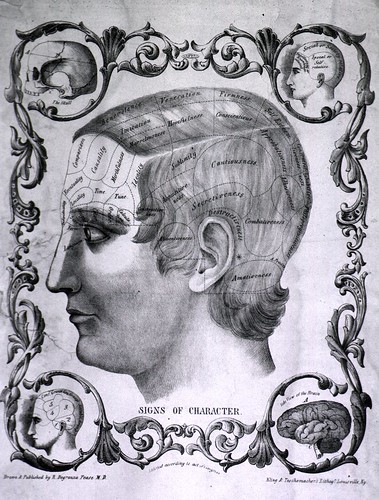

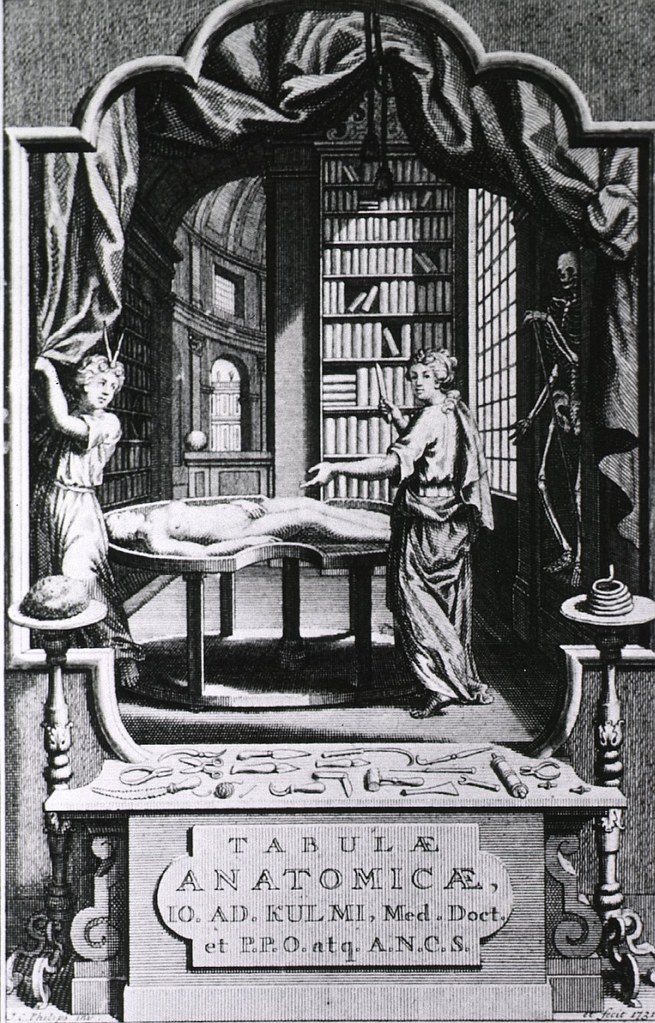
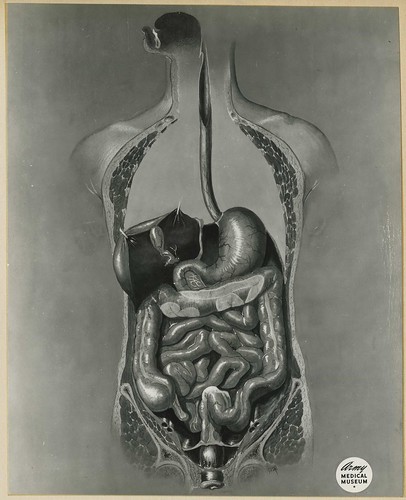
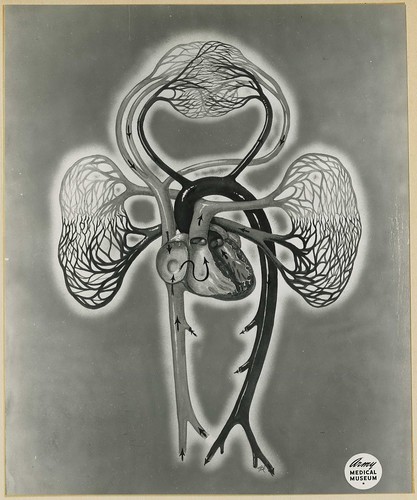


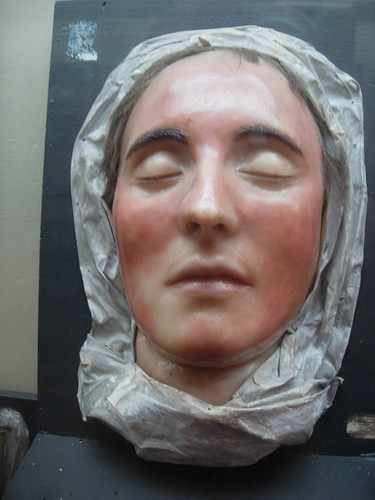
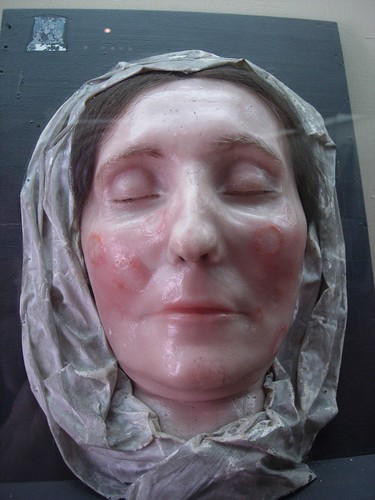

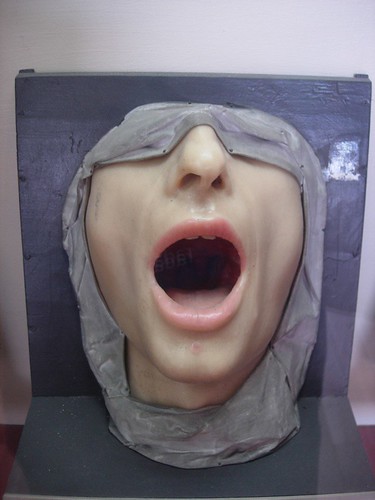
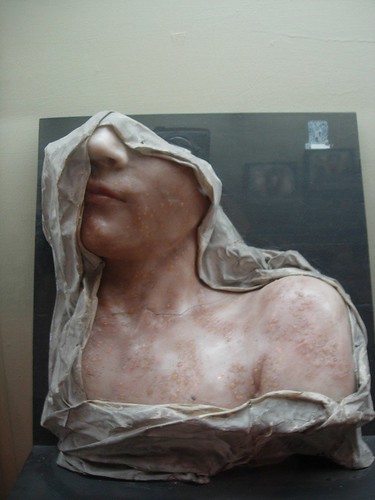
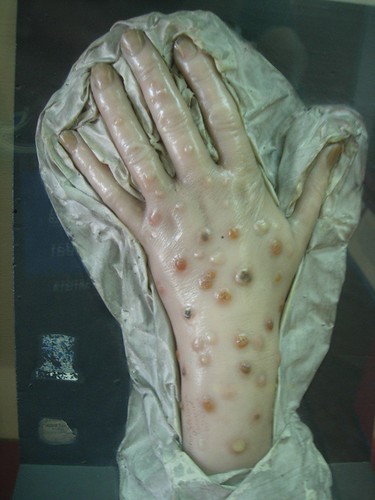
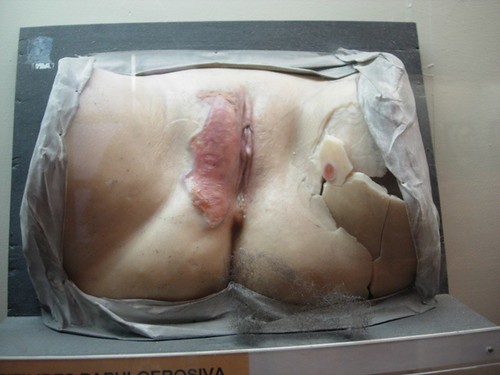
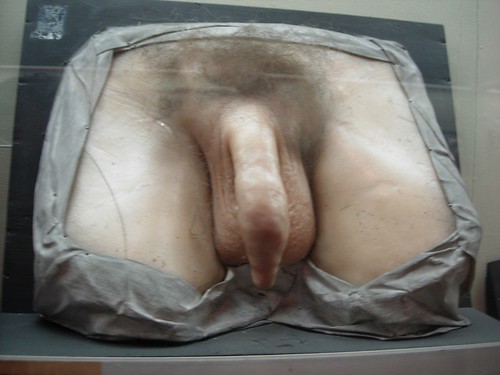
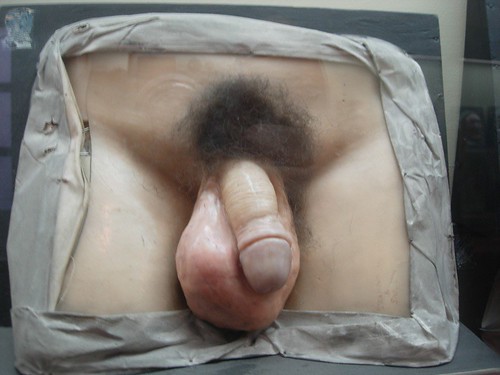
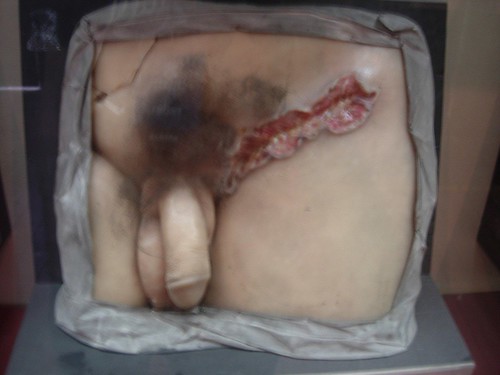




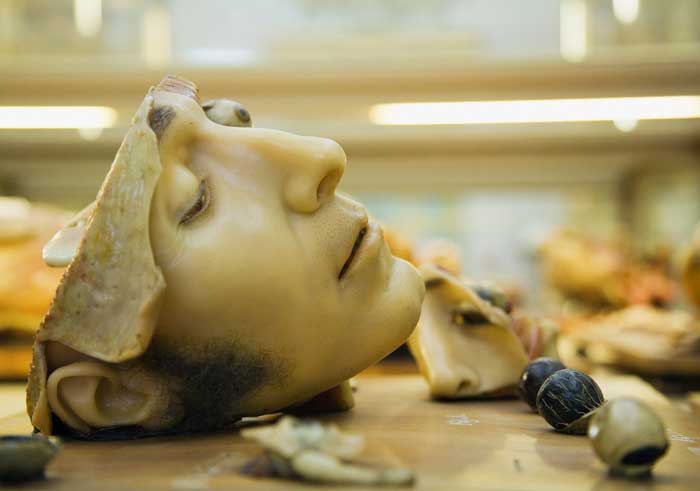
 , Dery explores this topic in three essays comprising the section "Dead Meat," the most directly medical-museumy of which is the wonderful essay "Nature Morte: Formaldehyde Photography and the New Grotesque." The good news is that Mark just linked from his
, Dery explores this topic in three essays comprising the section "Dead Meat," the most directly medical-museumy of which is the wonderful essay "Nature Morte: Formaldehyde Photography and the New Grotesque." The good news is that Mark just linked from his 




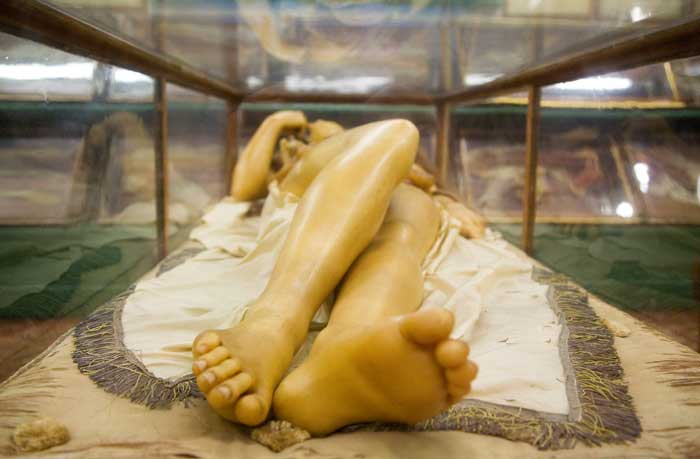
 --are considered by many to be the finest anatomical waxworks in the world.
--are considered by many to be the finest anatomical waxworks in the world.